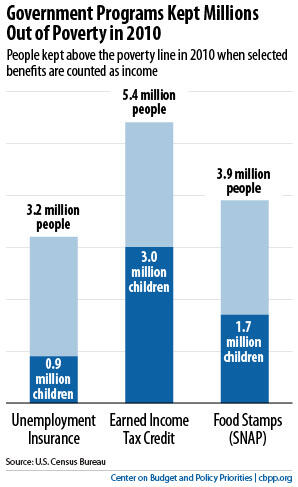off the charts
POLICY INSIGHT
BEYOND THE NUMBERS
BEYOND THE NUMBERS
Government Programs Kept Millions Out of Poverty in 2010
Receive the latest news and reports from the Center
Though grim in many respects, the Census data released this morning show that poverty and hardship would have been far worse in 2010 if not for key programs such as unemployment insurance, the Earned Income Tax Credit (EITC), food stamps, and Medicaid. The new figures send a powerful message to policymakers as they consider major changes in these programs this fall.

Congress will have to decide soon whether to continue unemployment benefits for the long-term unemployed, as well as other temporary initiatives designed to promote growth and ease hardship during the economic downturn. Also, Congress’ special deficit-reduction committee could consider deep cuts in basic low-income assistance.
The committee, and Congress as a whole, should adhere to a core principle that the Bowles-Simpson commission set forth in its report and the Senate’s “Gang of Six” sought to honor in its plan — deficit reduction should be designed so that it does not increase poverty — and therefore shield low-income assistance programs from cuts. Leaders of prominent religious, civil rights, charitable, and other organizations have urged policymakers to follow that key principle.
History shows that deficit reduction can go hand-in-hand with protecting those on the lower rungs of the income scale and even with stronger policies for low-income families. The three major federal deficit-reduction packages of the last two decades — those in 1990, 1993, and 1997 — actually reduced poverty and inequality, even as they shrank deficits substantially, by shielding core low-income assistance programs as well as through such measures as expanding the EITC.
If policymakers instead impose significant cuts in programs for those at the bottom of the income ladder, it will have a strong and negative effect on the extent and depth of poverty in coming years and decades.